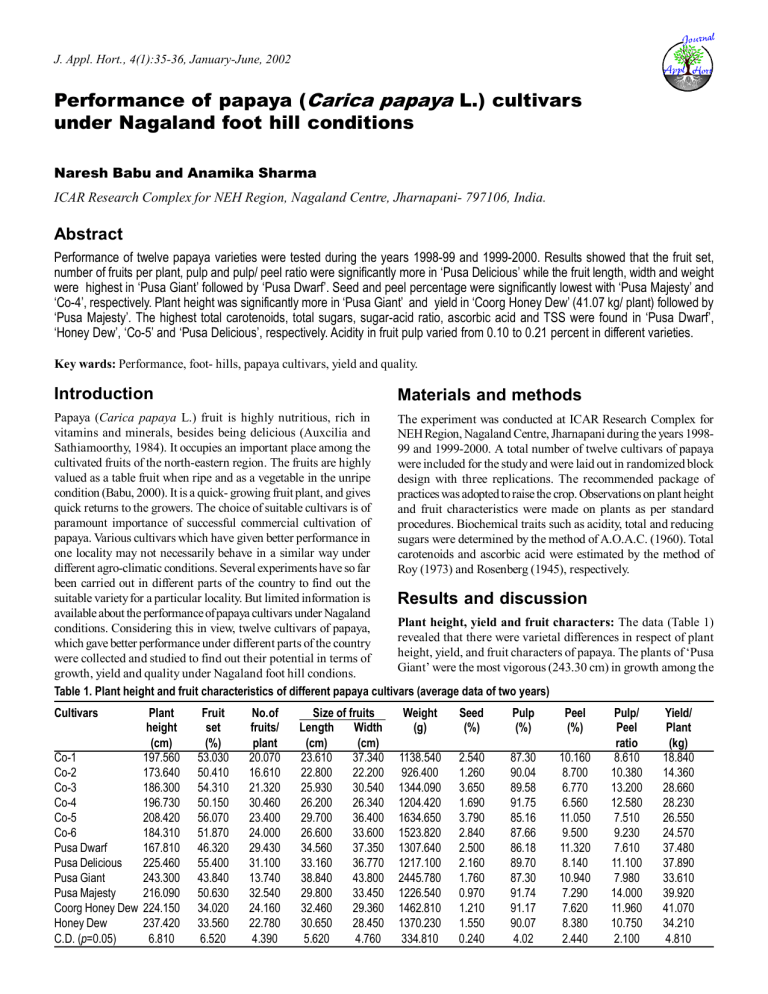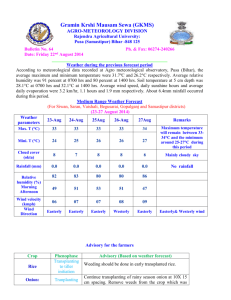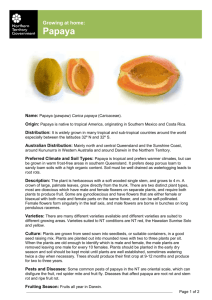
J. Appl. Hort., 4(1):35-36, January-June, 2002 Performance of papaya (Carica papaya L.) cultivars under Nagaland foot hill conditions Naresh Babu and Anamika Sharma ICAR Research Complex for NEH Region, Nagaland Centre, Jharnapani- 797106, India. Abstract Performance of twelve papaya varieties were tested during the years 1998-99 and 1999-2000. Results showed that the fruit set, number of fruits per plant, pulp and pulp/ peel ratio were significantly more in ‘Pusa Delicious’ while the fruit length, width and weight were highest in ‘Pusa Giant’ followed by ‘Pusa Dwarf’. Seed and peel percentage were significantly lowest with ‘Pusa Majesty’ and ‘Co-4’, respectively. Plant height was significantly more in ‘Pusa Giant’ and yield in ‘Coorg Honey Dew’ (41.07 kg/ plant) followed by ‘Pusa Majesty’. The highest total carotenoids, total sugars, sugar-acid ratio, ascorbic acid and TSS were found in ‘Pusa Dwarf’, ‘Honey Dew’, ‘Co-5’ and ‘Pusa Delicious’, respectively. Acidity in fruit pulp varied from 0.10 to 0.21 percent in different varieties. Key wards: Performance, foot- hills, papaya cultivars, yield and quality. Introduction Materials and methods Papaya (Carica papaya L.) fruit is highly nutritious, rich in The experiment was conducted at ICAR Research Complex for vitamins and minerals, besides being delicious (Auxcilia and NEH Region, Nagaland Centre, Jharnapani during the years 1998Sathiamoorthy, 1984). It occupies an important place among the 99 and 1999-2000. A total number of twelve cultivars of papaya cultivated fruits of the north-eastern region. The fruits are highly were included for the study and were laid out in randomized block valued as a table fruit when ripe and as a vegetable in the unripe design with three replications. The recommended package of condition (Babu, 2000). It is a quick- growing fruit plant, and gives practices was adopted to raise the crop. Observations on plant height quick returns to the growers. The choice of suitable cultivars is of and fruit characteristics were made on plants as per standard paramount importance of successful commercial cultivation of procedures. Biochemical traits such as acidity, total and reducing papaya. Various cultivars which have given better performance in sugars were determined by the method of A.O.A.C. (1960). Total one locality may not necessarily behave in a similar way under carotenoids and ascorbic acid were estimated by the method of different agro-climatic conditions. Several experiments have so far Roy (1973) and Rosenberg (1945), respectively. been carried out in different parts of the country to find out the suitable variety for a particular locality. But limited information is Results and discussion available about the performance of papaya cultivars under Nagaland Plant height, yield and fruit characters: The data (Table 1) conditions. Considering this in view, twelve cultivars of papaya, revealed that there were varietal differences in respect of plant which gave better performance under different parts of the country height, yield, and fruit characters of papaya. The plants of ‘Pusa were collected and studied to find out their potential in terms of Giant’ were the most vigorous (243.30 cm) in growth among the growth, yield and quality under Nagaland foot hill condions. Table 1. Plant height and fruit characteristics of different papaya cultivars (average data of two years) Cultivars Plant height (cm) Co-1 197.560 Co-2 173.640 Co-3 186.300 Co-4 196.730 Co-5 208.420 Co-6 184.310 Pusa Dwarf 167.810 Pusa Delicious 225.460 Pusa Giant 243.300 Pusa Majesty 216.090 Coorg Honey Dew 224.150 Honey Dew 237.420 C.D. (p=0.05) 6.810 Fruit set (%) 53.030 50.410 54.310 50.150 56.070 51.870 46.320 55.400 43.840 50.630 34.020 33.560 6.520 No.of fruits/ plant 20.070 16.610 21.320 30.460 23.400 24.000 29.430 31.100 13.740 32.540 24.160 22.780 4.390 Size of fruits Length Width (cm) (cm) 23.610 37.340 22.800 22.200 25.930 30.540 26.200 26.340 29.700 36.400 26.600 33.600 34.560 37.350 33.160 36.770 38.840 43.800 29.800 33.450 32.460 29.360 30.650 28.450 5.620 4.760 Weight (g) Seed (%) Pulp (%) Peel (%) 1138.540 926.400 1344.090 1204.420 1634.650 1523.820 1307.640 1217.100 2445.780 1226.540 1462.810 1370.230 334.810 2.540 1.260 3.650 1.690 3.790 2.840 2.500 2.160 1.760 0.970 1.210 1.550 0.240 87.30 90.04 89.58 91.75 85.16 87.66 86.18 89.70 87.30 91.74 91.17 90.07 4.02 10.160 8.700 6.770 6.560 11.050 9.500 11.320 8.140 10.940 7.290 7.620 8.380 2.440 Pulp/ Peel ratio 8.610 10.380 13.200 12.580 7.510 9.230 7.610 11.100 7.980 14.000 11.960 10.750 2.100 Yield/ Plant (kg) 18.840 14.360 28.660 28.230 26.550 24.570 37.480 37.890 33.610 39.920 41.070 34.210 4.810 36 Babu and Sharma-Performance of papaya (Carica papaya L.) cultivars Table 2. Fruit quality of different papaya cultivars (average data of two years) Cultivars Total carotenoids ( mg/100g) Co-1 5.210 Co-2 6.800 Co-3 7.390 Co-4 5.790 Co-5 4.520 Co-6 3.850 Pusa Dwarf 7.730 Pusa Delicious 5.630 Pusa Giant 3.380 Pusa Majesty 7.510 Coorg Honey Dew 6.850 Honey Dew 5.620 C.D. (p=0.05) 1.820 Total suger (%) 10.960 11.500 10.160 8.020 10.120 11.610 10.400 9.860 10.260 10.960 11.400 12.450 2.100 Reducing sugar (%) 10.080 10.430 9.800 7.320 9.150 10.430 9.380 8.460 9.150 9.870 10.230 11.570 1.340 Non-reducing sugar (%) 0.880 1.070 0.360 0.700 0.970 1.180 1.020 1.400 1.110 1.080 1.170 0.880 0.090 twelve cultivars as revealed by their height followed by ‘Honey Dew’ and ‘Pusa Delicious’. Cultivar ‘Co- 5’ produced maximum fruit set (56.07%) followed by ‘Pusa Delicious’ (55.40%). While in ‘Honey Dew’, ‘Coorg Honey Dew’ and ‘Pusa Giant’ fruit set was low. The size of fruits in terms of length, width and weight of fruit was maximum (38.84, 43.80 cm and 2445.78g, respectively) under ‘Pusa Giant’ whereas, the minimum values (22.80, 22.20 cm and 926.40g, respectively) of these parameters was found under ‘Co-2’. Observations indicated that the seed percentage was significantly lowest (0.97%) in ‘Pusa Majesty’ while the peel percentage was found significantly lowest (6.56%) under ‘Co- 4’ followed by ‘Co- 3’. The highest pulp and pulppeel ratio of fruits (91.74 and 14.02, respectively) were obtained under ‘Co- 4’, whereas the lowest values (85.16 and 7.51, respectivily) of these attributes were recorded in ‘Co- 5’. It has been observed that there were significant variations in fruit yield among the twelve cultivars. The cultivar ‘Pusa Majesty’ recorded the highest number (32.54/ plant) of fruits, whereas, the fruit yield in terms of weight was highest (41.07 kg/ plant) in ‘Coorg Honey Dew’. The cultivars ‘Pusa Dwarf’, ‘Pusa Delicious’ and ‘Pusa Majesty’ yielded fruits weighing more than 35 kg per plant. The possible reason for the variations of these characters genotype x environment interaction. Similarly, significant variations in the fruit characters of different varieties of papaya have been observed by Mansha Ram (1982) and Auxcilia and Sathiamoorthy (1984). Quality parameters: From quality point of view, eight biochemical constituents of pulp viz., carotenoids, total, reducing and non-reducing sugars, acidity, sugar-acid ratio, ascorbic acid content and TSS in the fruit had been studied (Table 2). The data revealed that the ‘Pusa Dwarf’ had the maximum (7.73 mg/100g) carotenoids followed by the ‘Pusa Majesty’ (7.51 mg/100g), whereas the lowest (3.85 mg/100 g) was recorded under ‘Co- 6’. ‘Honey Dew’ was the sweetest among the twelve cultivars due to its highest percentage of total sugar (12.45) and reducing sugar (11.57) and the lowest amount of non-reducing sugar and acidity Acidity (%) 0.210 0.130 0.160 0.110 0.170 0.180 0.160 0.130 0.170 0.190 0.210 0.100 0.040 TSS (%) 13.60 14.51 13.50 10.90 13.70 11.55 13.26 14.08 9.14 9.58 10.90 10.61 2.55 Sugar/ acid ratio 52.190 88.460 63.500 72.910 59.530 64.500 65.000 75.850 60.350 57.630 54.300 124.500 6.830 Ascorbic acid ( mg/100g) 62.520 47.500 41.860 55.320 71.860 28.370 37.750 56.860 71.460 56.910 47.290 41.890 4.560 (0.88 and 0.10%, respectively) in the fruits. Hence the sugar: acid ratio under ‘Honey Dew’ was found to be the highest (124.50). Ascorbic acid content was maximum with the cultivar ‘Co- 5’ (71.86 mg/ 100g) followed by ‘Pusa Giant’ (71.46 mg/ 100g) whereas, the lowest was recorded under ‘Co- 6’ (28.37 mg/ 100g). The highest total soluble solids (TSS) content (14.08 percent) was recorded in ‘Pusa Delicious’, whereas Mansha Ram (1982) recorded 13.00 percent in the same variety under Pusa, Bihar condition. Within a location season alters the TSS (Anonymous, 1957). Pal et al. (1980) recorded TSS of 12.00 percent in ‘Coorg Honey Dew’ under Bangalore condition. While in the present study, it had 10.90 percent, indicating the influence of eco-geographical variations. On the basis of yield and quality observed under Nagaland condition, cultivation of ‘Pusa Delicious’, ‘Pusa Majesty’, ‘Honey Dew’, ‘Coorg Honey Dew’, ‘Co- 2’ and ‘Co- 5’cultivers is recommended for the foot hills of Nagaland. References Anonymous, 1957. Wealth of India, CSIR, New Delhi. A.O.A.C., 1960. Official Methods of Analysis, A.O.A.C. Washington, D.C. Auxcilia, J. and S. Sathiamoorthy, 1984. Evaluation of gynodioecious papayas for yield and quality. South Indian Hort., 44 (5& 6):121123. Babu, Naresh, 2000. Effect of NAA, IAA and GA3 sprays on growth, yield and quality of papaya (Carica papaya L.) fruits under foot hills of Nagaland. New Agriculturist, 11(1&2):71-75. Mansha Ram,1982. Papaya improvement through selection and breeding technique. Punjab Hort. J., 22:8-14. Pal, D.K., M.D. Subramanyam, N.G. Divakar, C.P.A. Iyer and Y. Selvaraj, 1980. Studies on the physico-chemical composition of fruits of twelve papaya varieties. J. Food Sci. Tech., 17(3):254256. Rosenberg, S.R. 1945. Chemistry and physiology of the vitamins. InterScience Publishers, New York. Roy, S.K. 1973. A simple and rapid method of estimation of total carotenoids pigment in mango. J. Food Sci. Tech., 10(1):45.


